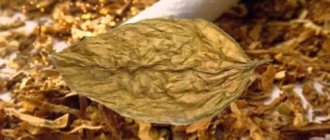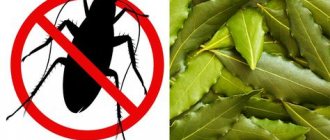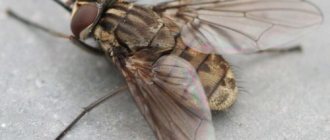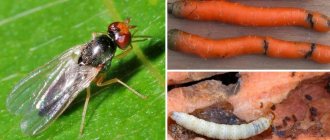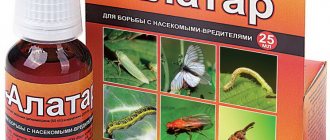Garden crops suffer not only from infectious diseases. Root crops are parasitized by worms. These are the larvae of adult insects. They can ruin the entire harvest. Experts recommend treating the soil and plants with insecticides to keep vegetables intact.
The preparations are used both in preparing soil for sowing and during the growing season of crops. Why do white worms appear in carrots? How to protect root vegetables?
Why are carrots wormy and what to do if they are attacked by a carrot fly
Small dark-red insects with porches do not pose a danger to root crops until they lay larvae there. It is the offspring of the fly that are engaged in “laying labyrinths”, because they need food to grow. They start from the top of the fruit, gradually gnawing holes along its entire length, as a result of which the plant begins to wither while still in the garden.
However, you can notice the infestation of carrot beds by a fly even at the initial stage - the tops near the head acquire a purple color.
You can fight carrot flies by spraying the plantings:
- infusion of wormwood or tomato tops;
- concentrated (2%) saline solution;
- insecticides (Decis, Actellik).
To prevent the appearance of flies, sprinkle tobacco dust mixed with ash over the area before sowing carrots. Insects cannot tolerate this smell. They also do not like the strong aromas of spicy crops, so plant onions or garlic next to the carrots.
Root nematode
A pest such as the root-knot nematode is especially troubling to gardeners. This is a white, small worm, 1.5 mm in size. It lives on the surface of the ground. It is difficult to notice; the moves the pest makes are very small.
Nematodes lay eggs in root crops. Numerous bumps appear on the surface of the carrot. The bulges increase in size. Worms emerge from them, which filter the juice and eat the pulp of the root crop.
The root-knot nematode is heterosexual. Males have a round shape and are 2 mm long. The body of the female is 1 mm. It has a pear-shaped shape. At one time, the female can lay up to 2.5 thousand eggs. A pair of nematodes produces up to 8 generations per year. The eggs take up to 2 months to develop. Main symptoms:
| № | Helpful information |
| 1 | numerous small holes on the soil surface |
| 2 | yellow carrot tops |
| 3 | deformed roots with numerous cones |
Fighting worms is difficult. They tolerate low temperatures down to -30 C, and die from high temperatures of 100 C and above. Insecticides are used for control, but the difficulty of use is that the parasites quickly get used to the chemicals. The drugs must be changed every time.
It is impossible to completely get rid of nematodes. What to do to preserve root vegetables? To combat parasites, chemicals and biological methods are used. When choosing a site for carrots, take into account crop rotation.
If the soil is contaminated with worms, it is recommended to treat it with formaldehyde or methyl bromide. These substances are very caustic and greatly disrupt the microflora in the soil. After treatment, the soil is not used for sowing.
More on the topic: What varieties of colored carrots are there?
Work is being carried out to restore its chemical and biological composition and improve fertility.
Modern scientists have developed new drugs against nematodes. They do not disturb the composition of the soil so much, but their effectiveness is slightly reduced. Gardeners are recommended to use the following drugs:
- “Fitoverm” – concentration 4 ml/l; treat the soil before sowing, irrigate until completely moistened; this amount is enough to process 1 m2; for insects use a concentration of 2 ml/l; spray bushes and soil; the volume is intended for an area of 5 m2;
- “Actofit” – concentration 0.5 kg/m2; a similar norm can be used for “Fitoverm” if the soil damage is total; the funds are introduced 2-3 days before sowing, the soil is dug up into 2 shovels;
- iodine solution - take 5 ml of the drug per 3 liters of solution; irrigate snow during melting; Iodine passes with melt water into the deep layers of the soil, prevents the development of bacteria, viruses, and resists insects and nematodes.
When growing carrots in industrial conditions, pesticides are used: “Carbofuran”, “Marshal”, “Aldoxycarb”. The drugs are toxic and require a period of discarding. They can be used against insect pests. Prepare a solution from 7 ml/10 l of water.
Igor Nikolaev
auto RU
To combat nematodes, a more concentrated solution is required. It is often applied together with mineral fertilizers, 15 ml/10 l.
If carrots are eaten by white worms, then it is no longer possible to save the fruits; non-standard methods are used to treat the soil. Manure, compost, sugar and sugar production waste are introduced. Saprophytes develop on these substances. These are plant-organisms. They provoke the appearance of predatory fungi, nematodes and mites that eat gall parasites. They do not attack root crops. The site can be used in 3-4 years.
Carrots with white worms are not eaten. It is dangerous for humans. Parasites produce toxins that cause poisoning. Root crops are burned. Nematodes are killed by high temperatures.
Experts warn that it is impossible to destroy all worms. This takes a lot of time. It is necessary to regularly cultivate the soil and plants.
More on the topic: How to store carrots?
How dangerous are wireworms for carrots?
Unlike the carrot fly, it is not so easy to notice this pest, because the above-ground part of plants at the initial stage often remains unchanged. In addition, the wireworm itself is a worm that lives in the soil, so it is not visible from above. It is located immediately in the fruits themselves, feeding on them. But in places where there are already fruits, the carrots begin to rot. Then the tops also fade.
If you discover the wireworm late, when the carrots are already growing, you can spread potatoes soaked in a special preparation Bazudin in the spaces between the rows. The pest will eat the poisoned tuber and die. Immediately after sowing, you can sprinkle ammonium nitrate over the beds. But it’s best to add ammonium sulfate to the digging in the fall. Or the same Bazudin mixed with sand.
Pest Control Methods
1. Carrot fly
- during the period of massive summer flies, sprinkle the soil in the beds where carrots grow with crushed wood ash mixed with tobacco dust, and loosen the soil with a garden rake;
- to repel insects, place perforated plastic bottles with mothballs on the beds, and plant onions in the spaces between the rows;
- Spray the sprouted crops with a soap solution mixed with an infusion of tomato leaves, grated garlic, fresh wormwood or yarrow;
- when the larvae emerge, water the carrots with a 2% solution of table salt;
- if folk remedies do not help, treat young plants with industrial insecticidal preparations, such as Actellik, Decis or Fitoverm.
exclamation scoop
Advice. Before thinning out the seedlings, in order to drown out the smell of carrot tops, which greatly attracts flies, water the beds with a water infusion of ground black pepper and scatter freshly picked wormwood between them.
2. Wireworm.
- Hydrogen nitride has a detrimental effect on click beetle larvae. To destroy wireworms, fertilize growing carrots with ammonia preparations, and in the fall, after harvesting, sprinkle ammonium sulfate (2 tablespoons per sq. m) on the beds and dig up the soil;
- if click beetle larvae have grown in large numbers, treat the beds with the insecticidal preparation “Bazudin”. To do this, mix a 30-gram sachet of the product with a kilogram of coarse sand and scatter it over an area of 4x5 m.
Advice. Place bait in the garden - bury potato halves cut side down in the ground (five centimeters deep) and twigs. Having smelled the smell of their favorite potatoes, the wireworms will crawl to the tubers and climb into them, but you will only need to dig up traps and burn them outside the site.
Exclamation owl larva
3. Exclamation scoop.
- To prevent infection, during the mass summer of butterflies, place trap jars with fermenting sugar molasses on the carrot beds. Attracted by the appetizing smell, the cutworms will pounce on the intoxicating treat and stick to the surface of the viscous sweet liquid;
- spray carrot tops with karbofos solution (1 tablespoon per bucket of water) or wormwood infusion.
Advice. If moth caterpillars have settled on your site, before winter, dig up the soil in the garden to the depth of a spade bayonet. During this operation, the cozy burrows of the pests will be destroyed and the caterpillars will die from frost.
To avoid damage to carrots.
it is necessary to regularly carry out preventive maintenance. The above remedies will help you destroy carrot pests, but still the basis of the fight for a high-quality harvest of root crops is prevention.
Regularly weed, observe crop rotation, constantly loosen and mulch the soil and you will not have to use potent pesticides to destroy uninvited harmful insects.
Prevention
The “war” against carrot pests takes up a lot of time for summer residents. It is much more effective to try to prevent the appearance of dangerous insects in the beds by following the rules for caring for and growing crops. To this end, do the following:
- alternate plantings on the site;
- maintain distance when sowing seeds or thin out carrot rows in a timely manner;
- remove weeds and loosen the soil;
- plant onions and strong-smelling plants (tagetes, calendula, fennel) next to the carrots, the smell of which repels pests;
- keep the beds in order after harvesting.
The measures are simple, but effective, allowing you not to lose the crop and prevent the invasion of crawling and flying pests.
Natalia Severova
Preventive measures
To prevent pests from appearing in carrot beds, take preventive measures:
- Remove weeds and do not attract the attention of insects.
- Maintain crop rotation. Plant carrots after onions, garlic, legumes, and tomatoes. You cannot plant carrots after potatoes, as they are often attacked by wireworms.
- Perform deep digging of the soil in late autumn. For the winter, pests hide in the soil 10-15 centimeters deep. When digging is done, they end up in the upper layers of the earth, which makes it possible to destroy them at the first drop in temperature.
- Carry out preventive spraying with the above listed folk remedies.
Compliance with the rules of agricultural technology and preventive measures will protect carrots from pests that make them wormy.
All your articles will be on this page.
The carrot fly may lay eggs in the garden bed if you thinned the seedlings too late. The exposed root crop becomes the object of close attention of the carrot fly. When the larvae emerge from the eggs, they immediately begin to “gnaw” the bark part of the root crop.
Affected root vegetables are no longer suitable for consumption as they have an unpleasant bitter taste.
Fighting the carrot fly is quite problematic because it continues to lay eggs for a long time. Every year, two generations of carrot flies appear.
If you are a supporter of chemical pest control, then use phosphorus preparations.
Carry out the first watering using them approximately two weeks after emergence. Then repeat watering with these pesticides twice at weekly intervals.
Before using the drug, carefully read the instructions that come with all pesticides.
What problems may arise when growing carrots?
Carrots are grown in almost every country house. This is not to say that this vegetable is too demanding and difficult to care for, like, for example, a tomato or eggplant. However, sometimes it also causes gardeners a lot of trouble. What difficulties can await those who start growing carrots?
- Poor seed germination. There may be several reasons for this. The most common is that you purchased low-quality seed material. To avoid this, try to purchase seeds only from reliable and trusted sellers. Another possible reason is unfavorable weather that occurred after sowing. Both drought and heavy rains can cause seed death. There is only one way out - to replant everything again.
- Cracks on the root crop. This is not just an external defect. Such carrots store worse and are more difficult to clean. Excessive watering or heavy rains can lead to this, especially if it has been dry for a long time before. In addition to irregular moisture, carrots can also crack due to excess nitrogen.
- Greening of the root crop. Usually the very top part turns green. The green color indicates that a toxic substance, solanine, has begun to accumulate in the carrots. The reason is the sun's rays that fall on the part of the root crop that is not covered with soil. To avoid this problem, carrots need to be hilled up from time to time, covering the bare areas with earth.
- Diseases. Carrots are most often affected by various types of rot: brown, wet, white, black, etc. The main cause of these problems is excessive moisture levels during the growing season or during storage. Insufficient levels of potassium in the soil can also cause the disease.
- Pests. Yes, unfortunately, we are not the only ones who love carrots. We also have competitors - carrot aphid, psyllid and carrot fly. Here we cannot do without a tough struggle: either we give them, or they give us the carrot.
Medvedka
It’s unlikely to miss a mole cricket in the garden. The insect, up to 5 cm in size, is brown in color, has powerful front legs and teeth that allow it to dig the ground. The insect has wings, but it does not fly short distances. The mole cricket takes root in humid areas near lakes and rivers, preferring soils enriched with humus. To continue the genus, the pest digs holes where it lays eggs from mid-May to the end of August.
Medvedka
The mole cricket feeds mainly on the stems and roots of plants, and also does not disdain small invertebrates, such as earthworms.
Methods of disposal:
- Bottle traps . Dig a hole next to the discovered mole cricket hole, pour some beer into the eggplant. Bury the container at a 30° angle or level with the ground so that the insect can climb inside. Attracted by the smell, the mole cricket will not be able to get out of the liquid.
- Alder branches . Place freshly cut branches between the carrot beds at a distance of 1.5-2 meters from each other. The insect does not tolerate the aroma of alder, but the branches will have to be changed once a week.
- Washing powder . A couple of spoons of detergent are diluted with a liter of water, then the holes are filled.
It is worth fighting mole crickets with chemicals if their numbers cause damage to the gardener. Preparations:
- Medvetox,
- Parachute,
- Thunder,
- BI-58.
Prevention of occurrence is deep digging of the soil.
Carrot eaten by a mole cricket
How to keep pests out of carrot beds?
Protection against pests, fungal and bacterial infections will be effective if carried out comprehensively. To understand how to fight, you need to know what diseases and pests love carrots.
- Poor, compacted soil is a breeding ground for fungal spores, pathogenic microbes, and pupated larvae.
- The pathogenic focus grows exponentially when a monoculture is cultivated in the same area.
- If you rely only on chemistry, then in a few years it will destroy not only harmful, but also beneficial insects and microorganisms.
What can you do to keep pests and diseases away from your carrot beds?
Agrotechnical techniques
Correct agricultural technology can, if not solve the problem, then seriously stop it.
- Make it a rule to prepare the soil in your garden beds in the fall. After digging, some of the disturbed insects, larvae, and microorganisms will die from rain, frost, or suffocate at depth.
- Plant root vegetables after cucumber, zucchini, cabbage, and onions - they have different pests and diseases. Monoculture is not encouraged, as it leads to the appearance in the soil of foci with a high concentration of infectious agents, especially of fungal origin.
- The application of fertilizers changes the environment familiar to pests, thereby worsening the conditions for their development. Plants, on the contrary, strengthen the immune system and become more viable.
- Many insects and pathogens actively reproduce in damp, weed-filled, dense plantings. To prevent them from getting a chance, thin out the crops in a timely manner, remove weeds, and mulch the soil surface.
- If there is the slightest suspicion that plants are infected with a fungus, immediately after harvesting, destroy plant waste.
Note! Mixed plantings bring mutual benefit in pest control. Onions and garlic planted next to carrots will infuse their spicy aroma and repel carrot flies. Marigolds and calendula will attract the worst enemies of flies - ichneumonid insects.
Seed protection
Infection with rot of fungal etiology occurs from two sources - soil and seeds. To protect the seed material, it is disinfected before planting. Treating with Fitosporin-M, Rizoplan, and Trichodermin gives a good effect. A good option is to purchase encrusted or pelleted seeds treated with fungicides or insecticides.
Late varieties of carrots intended for long-term storage, new selection hybrids are more resistant to diseases and damage to crops by carrot flies.
Compliance with storage conditions
Infected root crops rarely rot in the field. The impetus for the rapid development of pathogenic microflora is usually given by improper harvesting and storage conditions.
Optimal conditions for cleaning are dry, cool weather. Storing wet root vegetables will cause rotting. This is also facilitated by high air humidity and storage temperatures exceeding the recommended 1–4⁰ C.
Reasons why carrots become wormy
In order to prevent wormy carrots, you need to understand what you are dealing with. So, the main reason for the appearance of worms in carrots is the activity of one of two pests: wireworms or carrot flies.
The first is a small worm that loves to eat juicy carrot fruits almost from the first days of their development in the soil. By the way, in the first year of its life, the wireworm does not touch the roots of crops - it feeds on small roots of plants. He especially loves wheatgrass. The wireworm is the larva of the click beetle and is a small yellow worm about 2-3 cm long. Unfortunately, it is almost impossible to get rid of this pest 100%, but with the right preventive actions, you can minimize the number of larvae in your garden plot. But more on that later.
The second pest is much more dangerous. The carrot fly can cause considerable damage to the crop ripening in the garden beds. It has a brown body (about 0.5 cm long) with a black belly. Usually the fly appears in the garden plot by May. To prevent its active “activity”, it is necessary to detect it in time. To do this, you only need a small container of fermented kvass. Just place it not far from the carrot beds and in the late afternoon (the fly does not like to fly in the heat) the fly will appear to feast on it.
16 excellent varieties of plums for the Moscow region
If by night (by morning) the fly does not swim in the kvass, all that remains is to pay attention to the visual signs of the “presence” of the pest: a bronze coating on the leaves and the presence of larvae in the dug root crop. Carrot fly larvae, by the way, are very small in size - about 0.5 cm, and have a pointed head.
Attention! The egg laying cycle of the carrot fly is about 3-4 months, so after the destruction of the first “batch” of larvae, you should continue to take measures to combat the pest and periodically monitor the condition of the root crops on the site.
